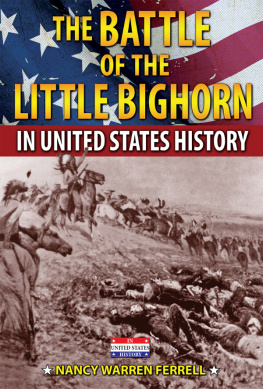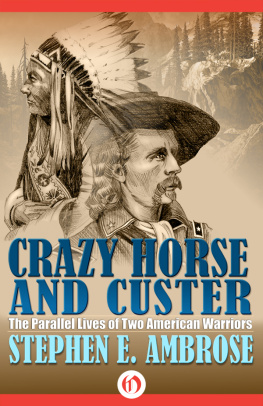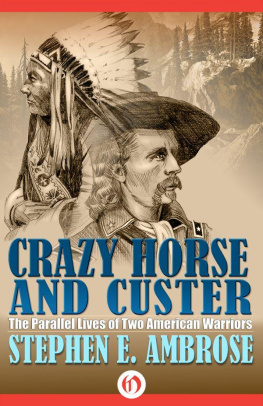Custer's Last Stand
In Montana, on June 25, 1876, Lieutenanat Colonel George Custer and the Seventh U.S. Cavalry faced thousands of Native American warriors. Inspired by Sitting Bull and led by Crazy Horse and Gall in the battle that followed, the warriors of the Sioux and Cheyenne nations wiped out more than 260 men under Custer's command
In The Battle of the Little Bighorn in United States History, author Nancy Warren Ferrell explores the trail of events which led to one of the most famous battles in United States history. The author describes the colorful and famous men who took part in this battle including: Sitting Bull, Crazy Horse, Marcus Reno, and George Armstrong Custer. The author explains how the conflicts between these two cultures would eventually lead to the battle on the banks of the Little Bighorn River.
"...especially strong in bringing to life a handful of key players."
The Horn Book Guide
"The coverage is balanced and well documented..."
School Library Journal
ABOUT THE AUTHOR
Nancy Warren Ferrell has published both juvenile and adult nonfiction books. She has taught school and worked as a book reviewer and librarian.

In May of 1876, a large Sioux and Cheyenne camp crowded along the Rosebud River in Montana Territory. It was a typical morning. In the distance, young boys herded horses. Nearer at hand, children darted between tepees, dogs barking at their heels. Women prepared breakfast. The savory smell of buffalo meat drifted in the air. It was a peaceful scene.
But peace was not on the mind of Sioux Chief Sitting Bull. Soon his men would fight government soldiersthe Bluecoatswho were searching for hostile warriors. Sitting Bull was preparing for war.
That morning Sitting Bull took the feather from his hair and loosed his black braids. He washed the red paint from his face. Then he picked up his long pipe and wound sprigs of sage around the stem.
When he was ready, he asked three warriors to go with him. Together they climbed a nearby hill. There Sitting Bull faced the sun, holding the pipe stem toward the sky. Then he made his prayer to the sun, asking that the Sioux nation be successful in what they were to do. Sitting Bull also promised to hold a Sun Dance, hoping a vision of the future would come to him.
In time, the Sun Dance was performed. During the ceremonies, Sitting Bull received a vision.
In this vision, the Sioux chief heard a voice from above saying, I give you these because they have no ears. Then in his dream Sitting Bull saw soldiers dropping upside down from the sky. The Bluecoats had no ears, and their hats were falling off. The soldiers were falling into camp.
Everyone celebrated when they heard the vision, for they knew what it meant. The soldiers who would not listen to peaceful talk would comeyes. They would come, but they would be defeated! The Sioux would win a great and glorious victory.
Early Sioux had a saying: A people without history is like wind on the buffalo grass. The heritage of Sitting Bull and of all Native Americans goes back thousands of years.
When Europeans stepped upon the North American continent in the late 1400s, they found people already there and named them Indians. (The European explorers thought the ships had sailed to the country of India.) These Native Americans lived different lifestyles and spoke different languages, often communicating through sign language. No one knows for sure, but around the year A.D. 1500 close to 5 million Native Americans lived in what is now the United States.
Before the white adventurers arrived on the North American continent, very few Native Americans lived on the Great Plains between the Mississippi River and the Rocky Mountains. Before the explorers, the Indians had lived as farmers and small-time hunters on the fringes of the plains, doing their work and traveling afoot. Native Americans only pack animal, the dog, could neither go very far nor carry heavy loads. Because of this, few tribes lived on the Plains.
The arriving Europeans who brought horses and guns in the late 1400s changed much of the Plains lifestyle. In the decades after, through trading and stealing, tribes obtained horses. By the 1800s, Plains hunters such as the Sioux, Cheyenne, Crow, Blackfeet, Comanche, and Kiowa tamed wild horses and rode them expertly.
What a difference the horse made, especially on the Great Plains of America. It actually created a new lifestyle for Native Americansas wanderers. Whereas a tribal camp might move six miles a day using dogs to pull loads, a camp with horses could travel thirty miles in an emergency.
Warring and raiding against other tribes proved a basic part of Native American life. The reasons for raiding might be for revenge, for horses, for plunder, or in defense of tribal territory. It was not a game, but serious business.
A major change brought by the horse dealt with a primary food of the wandering tribal bandsthe buffalo. These huge animals supplied just about everything for the Plains family.
Before the horse, warriors stalked buffalo on foot. Hunters tried to hide from the animal and kill it by surprise. Or they stampeded the animals over a cliff, then killed them as they lay injured below. The horse enabled riders to travel farther from camp in search of buffalo. Because of the enormous number of buffalo herds ranging the Plains, people were able to put a supply of food away for leaner times.
The Plains tribes became dependent on the buffalo. A large buffalo supplied enough meat to feed a hundred people. Even the dried droppings of the beastbuffalo chipsfueled fires when wood was not available. Because of these many gifts, tribes held religious ceremonies to honor the animal. Buffalo proved the one source from which stemmed the peoples very existence.
Along with the horse, Europeans also introduced guns to America. On average, a warrior could shoot twenty arrows in the time it took to load and fire a musket gun once. Yet they saw the advantage of the noise, smoke, surprise, and effectiveness of the weapon. Tribes were quick to adopt them. The combination of horse and gun made the Plains rider an impressive fighter.
The horse and the buffalo provided these people with an independent, roving Plains life. Other than enemy tribal territories, there were no boundaries on land. It was a mobile, free existence.
This Sioux were made up of closely related tribes:
Oglala
Brul
Hunkpapa
Sihasapa
Miniconjou
Oohenonpa
Itazipco
Yankton
Yankonai
Hunkpatina
Assiniboine
Mdewakanton Tribe
Wahpeton Tribe
Wahpekute Tribe
Sisseton Tribe
But as the explorers, mountain men, miners, adventurers, soldiers, and white settlers moved ever westward across the country during the mid-1800s, the buffalo began to disappear. The buffalo roamed in herds ranging from five to fifty, and sometimes hundreds of thousands of animals covered the hills. The buffalo supported the economy and influenced the warfare, religion, and society of the Native Americans. This animal, the very essence of Plains life, was fast disappearing.
Cheyenne and Sioux were only two of many tribes that hunted on the Great Plains of America. The Cheyenne were divided into northern and southern groups while the Sioux were divided into several groups.
The life of these Plains people was different from that of the invading white society. The reasons for war were also different.
For the tribal individual, the primary goal of warfare was to show bravery. To touch an enemycalled a







